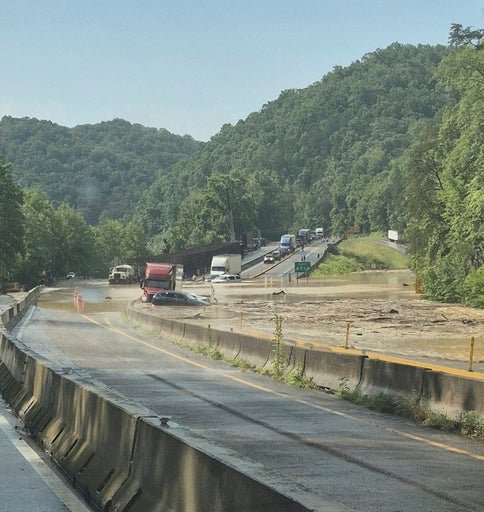Interstate 40 Reopens in the Great Smoky Mountains After Nine-Day Closure
As someone who’s spent years exploring and writing about the enchanting landscapes of the Great Smoky Mountains, I’ve seen this treasured region weather many storms. The recent reopening of Interstate 40 through the Smokies marks another chapter in the area’s ongoing recovery from Hurricane Helene’s devastating impact.
On Friday, crews successfully reopened a section of Interstate 40 that runs through the narrow corridor of the Great Smoky Mountains after a nine-day closure caused by flooding and a rock slide. This major cross-country highway serves as a vital artery for both locals and travelers crossing the breathtaking mountain range that straddles Tennessee and North Carolina.
The Ongoing Recovery from Hurricane Helene
When I first heard about the closure, my heart sank. Having traveled this scenic route countless times, I know just how crucial this roadway is to the region. The interstate was already undergoing significant repairs following the massive damage and washouts caused by Hurricane Helene last fall.
The reopening represents a small but meaningful victory in the long recovery process for the Great Smoky Mountains region. As anyone familiar with the area knows, these mountains are resilient, but the infrastructure that allows us to access their beauty requires constant maintenance and occasional major repairs, especially after extreme weather events.
The Importance of I-40 to the Smoky Mountain Region
Interstate 40’s path through the Great Smoky Mountains isn’t just any highway. It’s a engineering marvel that connects the eastern and western portions of Tennessee through a dramatic mountain landscape. The narrow corridor presents unique challenges for road maintenance crews, as the steep terrain makes repairs particularly difficult.
For local communities, tourists, and commercial traffic alike, this interstate serves as a lifeline. When closed, travelers must take significant detours that add hours to their journeys and put pressure on smaller local roads not designed for heavy traffic volumes.
Impact on Local Tourism and Economy
The Smoky Mountains region depends heavily on tourism, and highway closures can have ripple effects throughout the local economy. With summer approaching—traditionally one of the busiest seasons for visitors to the Great Smoky Mountains National Park—the reopening comes at a critical time.
Having witnessed firsthand how weather events can impact visitor numbers to the Smokies, I’m relieved to see this major access point restored before peak tourist season arrives in full force.
The Challenges of Mountain Highway Maintenance
Maintaining highways through mountainous terrain presents unique challenges that flat-land roads don’t face. Rock slides, flooding, and erosion are constant threats that road crews must vigilantly monitor and address.
The section of I-40 that runs through the Smokies is particularly vulnerable due to its position along river valleys and steep mountain slopes. When heavy rains come, as they did during Hurricane Helene, the combination of saturated ground and gravity can quickly lead to dangerous conditions.
Looking Forward: Infrastructure Resilience
As climate patterns change and extreme weather events become more common, the question of infrastructure resilience becomes increasingly important for mountain communities. The repeated closures of I-40 in recent years highlight the need for long-term solutions that can better withstand the forces of nature.
Having traveled through the Smokies during all seasons over many years, I’ve noticed the increasing frequency of weather-related road issues. While the mountains themselves have stood for millennia, our human pathways through them require ongoing adaptation and reinforcement.
Visiting the Smokies After Road Reopenings
If you’re planning a trip to the Great Smoky Mountains in the coming weeks, the reopening of I-40 is excellent news. However, I’d still recommend checking road conditions before departing, as ongoing repair work may cause delays or temporary lane closures.
The Great Smoky Mountains National Park itself remains one of America’s most visited natural treasures, and for good reason. Its diverse ecosystems, abundant wildlife, and stunning vistas continue to captivate visitors despite the occasional access challenges.
A Personal Note on the Smokies’ Resilience
Having written about these mountains for years, I’ve developed a deep appreciation for their resilience. From forest fires to floods, the Smokies have faced numerous challenges, yet they continue to stand tall, their misty peaks a testament to nature’s enduring strength.
The reopening of I-40 is more than just a traffic update—it’s a symbol of the ongoing relationship between these ancient mountains and the people who call them home or visit them in search of natural beauty and peace.
Conclusion
While the reopening of Interstate 40 through the Great Smoky Mountains marks an important step in the region’s recovery from Hurricane Helene, it also reminds us of the ongoing challenges faced by mountain communities and infrastructure. As we continue to enjoy the beauty of these ancient mountains, we must also recognize the effort required to maintain our access to them.
If you’re planning a trip to the Smokies this summer, take a moment during your drive along I-40 to appreciate not just the magnificent views, but also the hard work that goes into keeping this vital artery open for all to enjoy.

